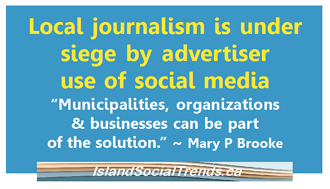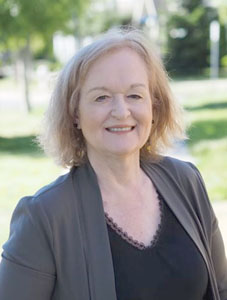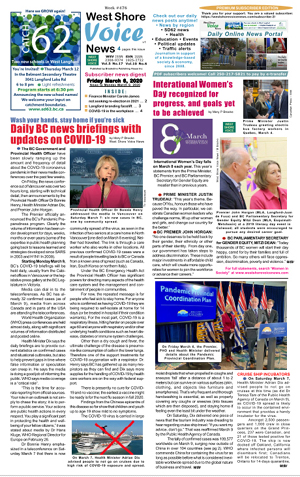Friday August 11, 2023 | LANGFORD, BC [Updated September 4, 2023]
Insight editorial by Mary P Brooke, B.Sc., Cert PR – Editor and Publisher | Island Social Trends
[In-person presentation available to municipalities, boards & organizations. Contact editor@islandsocialtrends.com to arrange.]
The importance of journalism to society is seen locally through the work of news outlets who report up close on their communities.
This will be a topic of discussion at City of Colwood’s regular council meeting on September 11. [Colwood agenda item has since been CANCELLED.] A presentation “Local News Media – Role & Challenges” is available. [The presentation is also available to other municipalities – contact editor@islandsocialtrends.com to arrange]
About the presenter:
Mary is an active journalist on the west shore, writing about local issues and attending media announcement events as well as municipal, school board, library, community groups and health authority meetings. She reports with the BC legislative press gallery.
Her Brookeline Publishing House Inc business office has been located in Langford since 2017, while before that her office was in Sooke (2007-2017), and before that in Oak Bay (1995-2007).
In 2008 Brooke founded a west shore publication series which has covered news of the region non-stop for now 15 years (MapleLine Magazine, 2008-2010; Sooke Voice News, 2011-2013; West Shore Voice News, 2014-2020; and now Island Social Trends, 2020 to present).
The west shore region generally includes Langford, Colwood, View Royal, Metchosin and Highlands as well as Sooke and the Juan de Fuca areas. Coverage all includes the broader Greater Victoria area as well as BC provincial news and also national news where there’s an impact for Vancouver Islanders.

The print editions of MapleLine Magazine, Sooke Voice News and West Shore Voice News (covering regional news from 2008 to 2020) have been archived in the permanent collections at the Sooke Region Museum.
Ms Brooke also wrote the inaugural curriculum for Writing for Business and Journalism (for the Western Academy of Photography in Victoria, back in the 1990s) before returning to running her business Brookeline Publishing House Inc full time. That journalism training program has been foundational for many government and freelance writers, communicators and photographers for decades.
Mary Brooke was a co-founder of the Professional Editors Association of Vancouver Island (PEAVI). Over the years she has created new standards for design and layout for community documents and corporate annual reports and newsletters.
This year, Ms Brooke was nominated for a Jack Webster Foundation award that recognizes a woman journalist in BC who contributes to her community through journalism.
Community resource:
When the pandemic hit in 2020, Mary Brooke morphed her weekly news publication into the daily Island Social Trends — presented entirely online. That portal offers free news access to anyone who visits the IslandSocialTrends.ca. The IslandSocialTrends.ca portal serves as an online news archive for the region, as a community service and ongoing resource.
Paid subscriptions help keep all that afloat, as well as ads from around the community. Reader visits to pages creates ‘hits’ (that helps too). To maintain impartiality, the enterprise does not accept government grants (not that many grants are available to newspapers, frankly).
News being available to every reader is part of the Island Social Trends mission to make community information available to all (which is also the bedrock mission of the original World Wide Web).
Why now:
Brooke is coming forward now with this presentation to Colwood council (available to other municipal councils as well), because she sees the interworking of municipalities (as well as school boards and large organizations) and media as a key community relationship in the fast-growing west shore.
Currently that relationship is top-heavy with public relations, marketing and advertising which largely, by default, excludes any journalism or involvement of news outlets.
It seems that journalism coverage by local news outlets has — for many municipalities, organizations, boards and government — become a ‘nice to have’ (especially if TV coverage) but is generally nowadays considered non-essential. If media don’t show up or cover an issue in detail, entities go ahead and post their information anyhow (or have done so ahead of the event or announcement). That’s uncurated by context or other points of view.
Some marketing consultants teach courses on how to ‘use the media’ for free coverage. Sadly, in many cases, news coverage has become a process of ‘comforting the comfortable’ — an extended public relations tool for governments, businesses, organizations, school boards and other entities that impact the lives of many or most people in the community.
It seems that news coverage is, for some entities, experienced as almost an intrusion rather than an opportunity to serve their part in the public discourse. When entities of impact dismiss the journalism component they are, by default, disregarding the broader public’s right to fair and open coverage.
Without journalism, people in the community would only hear one side of a given issue or announcement (i.e. public relations and marketing messages) or would need to undertake the work of assembling a balanced view through their own search for information.
Whether the community realizes it or not, they rely on local editors, journalist and their publishers to stand up to the pressures from those who seek news coverage — to make sure it is balanced and fair. It might be a job, but it is also a form of sometimes selfless community service.
Opportunity for municipalities:
For several years there has been an opportunity for municipalities (as well as larger governments, non-profits, local groups, and businesses) to rebalance that working relationship. Some municipalities have begun that process, while others have completely ignored a supportive arms-length integration with local media.
Advertising placed by municipalities and other organizations in small news publications (print or online) is not just available for event-promotion but also for general branding presence and to provide leadership by helping draw attention to issues of the day.
Ads from municipalities or organizations also show support for the function of local journalism within the broader community; that need not imply endorsement of all the content of the publication.
For municipalities, placing advertisements in local news outlet platforms is as much a social support statement as it is a business decision to ‘get hits’ on their website.
Role of journalism:
The societal role and function of journalism — as delivered by and through professional news media outlets — is to gather facts and present them with context. That information benefits the public as well as those who hold power through governance and business.
Journalism is generally intended to hold elected governments, the corporate sector, and other leadership streams to account. But it’s not as hard-hitting as it sounds.
Journalism can serve to mediate an issue, allowing multiple sides of an issue to be presented and better understood by the community.
Local community news outlets build their range of contacts over time, and can readily access the information needed for a breaking news story or to fill in blanks in issues that have been going on for a while. Reporters and editors build working relationships over time that can be very handy when accurate and reliable information is needed quickly or succinctly.
The act of recording words and images in real time is also part of building history from which many other sectors benefit including government, business, historians, news pundits, social issue advocates, comedians, entertainers, and others, to name a few.
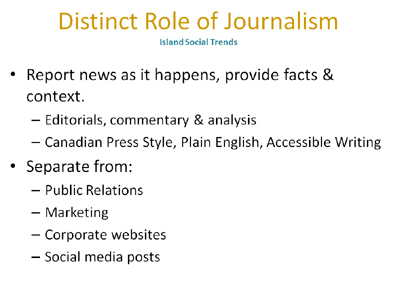
Pressures from social media:
The traditional role of journalism has been pressured through many changes brought on by online digital technology and widespread use of social media.
Without a reliable and profitable business model it’s not reasonable to expect journalism to be delivered with the same consistency (or even availability) as before.
Every individual, group, organization or level of government that uses social media to inform or promote is undercutting the traditional news outlet business model. Apparently now about 80% of media ad revenue in Canada goes to Facebook and Google or other areas of the social media landscape.
While saving money has been the primary motive for advertisers to shift from ‘newspapers’ to social media (which seems free), the greater loss is the previously healthy churn of informational discourse in the community.
Posting an event or policy announcement in social media is public relations or marketing, not journalism. Readers and viewers are losing a sense of what’s real or at least what is unbiased. Worse case scenario is that people tune out the news, and that dangerously leads to a poorly informed citizenry and electorate.

C-18 will create a two-tier media landscape in Canada:
The federal government has brought in Bill C-18: An Act respecting online communications platforms that make news content available to persons in Canada in an effort to help professional news outlets of all sizes be recognized in the possibility of negotiations with tech giant corporations who hold the lion’s share of online social media advertising revenue.
However, it’s becoming more clear that smaller news outlets will not be assisted by C-18. The larger news entities will have more legal sway in negotiations with large tech corporations and by sheer volume will generate most of any available revenue from Facebook and Google.
Thereby, Bill C-18 will create a two-tier system of news outlets in Canada, with the smaller players being even more disadvantaged than they are now.
This is a perfect case where lawmakers are generally not business people, and even with all good intentions have meddled in ways that have numerous unintended (though pre-warned) consequences.
Background on C-18:

Back in June during debate on Bill C-18, Island Social Trends was mentioned in the House of Commons by Alistair MacGregor, MP (Cowichan-Malahat-Langford) as one of five news outlets on south Vancouver Island who contribute to the west shore news landscape.
Section 2(b) of the Canadian Charter provides that everyone has freedom of thought, belief, opinion and expression, and includes freedom of the press and other media of communication.
What’s not news:
Use of the Internet makes it easy for non-news entities to appear as news. Folks know that as ‘fake news’ but that label makes it sound less serious than it really is.
Inaccurate or deliberately fake news can steer public discussion inappropriately or even dangerously.
Entities that are not news organizations include all sorts of advocacy groups, policy agencies, spoof and humour sites, and news-pretenders.
Not everyone takes the time to develop strong media literacy skills. These heavily-laden streams of information tend to suck up the news-space attention of people who seek reliable or balanced information on the Internet.
Best protection is ad buys in local outlets:
Professional news agencies — large or small — who can prove their commitment to covering community news factually and reliably over time, are the ones who C-18 should be protecting.
But the best protection will come from any level of government, agency or business with a website and email… to shift some of those advertising dollars over to local news outlets.
Without dedicated local journalists there will be a gap in societal history going forward.
No, it’s not enough to think it’s all ‘out there’ on the Internet at one’s finger tips… pages can be edited or removed, and are generally not archived in any usable way. Newspapers-of-old did that. Modern news portals do that.
News consumers need to stick up for something that serves them daily, whether or not they use it daily.
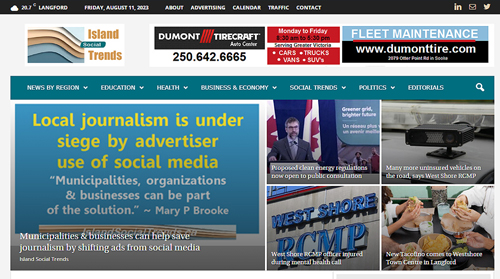
===== ISLAND SOCIAL TRENDS:
===== RELATED:
Governments dropping ads from Facebook (July 11, 2023)
Island Social Trends drops Facebook (June 22, 2023)
Langford launches Facebook page & online community forum (June 21, 2023)
Island Social Trends local journalism program for high school students (March 2, 2023)
International Day of Democracy includes view on journalism (September 15, 2022)
NDP draws attention to challenges of women in journalism (August 25, 2022)


